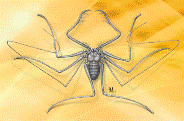Papers in the Biological Sciences

Eileen Hebets Publications
Document Type
Article
Date of this Version
1-1-2008
Abstract
Arthropod filiform hairs respond to air particle movements and are among the most sensitive animal sensory organs. In many species, they are tuned to detect predators or prey and trigger escape or prey capture behaviours. Here we show for the first time that these hairs also receive intraspecific near-field sound signals in an arachnid. During agonistic encounters, whip spiders (Arachnida, Amblypygi) perform antenniform leg vibration (ALV) displays that have significantly longer duration in contest winners than losers. During an ALV display: (i) the vibrating antenniform leg of the displaying whip spider is positioned close to the trichobothria (filiform hairs) on its opponent’s walking legs, (ii) the vibrating antenniform leg can excite these trichobothria via air movements and without direct contact, (iii) the antenniform leg of the displaying whip spider vibrates at a frequency that causes particularly strong, sustained excitation and little adaptation in the trichobothria, and (iv) the duration of an ALV display can be extracted from the response of a trichobothrium. Since filiform hairs are widespread among arthropods, communication via such hairs could be extremely prevalent.
[Includes supplemental materials.]


Comments
Published in Proceedings of the Royal Society B 275 (2008), pp. 363-368; doi 10.1098/rspb.2007.1466 Copyright © 2007 The Royal Society. Used by permission. http://publishing.royalsociety.org/index.cfm?page=1569